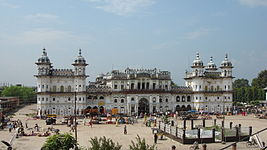
Janaki Mandir (Nepali: जानकी मन्दिर) is a Hindu sanctuary in Janakpur in the Mithila locale of Nepal, devoted to the Hindu goddess Sita.[1]
It is a case of Hindu-Rajput Nepali engineering. It is frequently viewed as the most essential model of Rajput engineering in Nepal. Completely worked in brilliant white and developed in a region of 4,860 sq. feet in a blended style of Islamic and Rajput vaults, the sanctuary is 50 meters high. It is a three-storied structure made completely of stone and marble. All its 60 rooms are designed with the banner of Nepal, shaded glass, inscriptions and sketches, with wonderful cross section windows and turrets. As indicated by legends and sagas, King Janak ruled this territory (called Videha) amid the Ramayana time frame. His little girl Janaki (Sita), amid her swyambar, had picked Lord Rama as her significant other, and progress toward becoming ruler of Ayodhya. Their wedding function had happened in the adjacent temple.The sanctuary is famously known as the Nau Lakha Mandir (signifying "nine lakhs"). The cost for the development of the sanctuary was about a similar measure of cash: rupees nine lakhs or nine hundred thousand, thus the name. Ruler Vrisha Bhanu of Tikamgarh, India constructed the sanctuary in 1910 AD.
In 1657, a brilliant statue of the Goddess Sita was found at the very spot, and Sita is said to have lived there. The legend said it that it was based on the blessed site where Sannyasi Shurkishordas had discovered the pictures of Goddess Sita. Truth be told, Shurkishordas was the author of present day Janakpur and the colossal holy person and artist who lectured about the Sita Upasana (additionally called Sita Upanishad) rationality. Legend has guaranteed it that King Janak(Seeradhwaj) played out the love of Shiva-Dhanus on this site.
Starting at 26 April 2015, the sanctuary is accounted for to have mostly caved in from the seismic tremor in April 2015.[2]Every year, a great many travelers from Nepal, India, Sri Lanka and different nations visit Ram Janaki Temple to venerate Lord Ram and Sita. Amid the celebrations of Ram Nawami, Vivaha Panchami, Dashain and Tihar, there is a nearness of considerably more admirers.
No comments:
Post a Comment